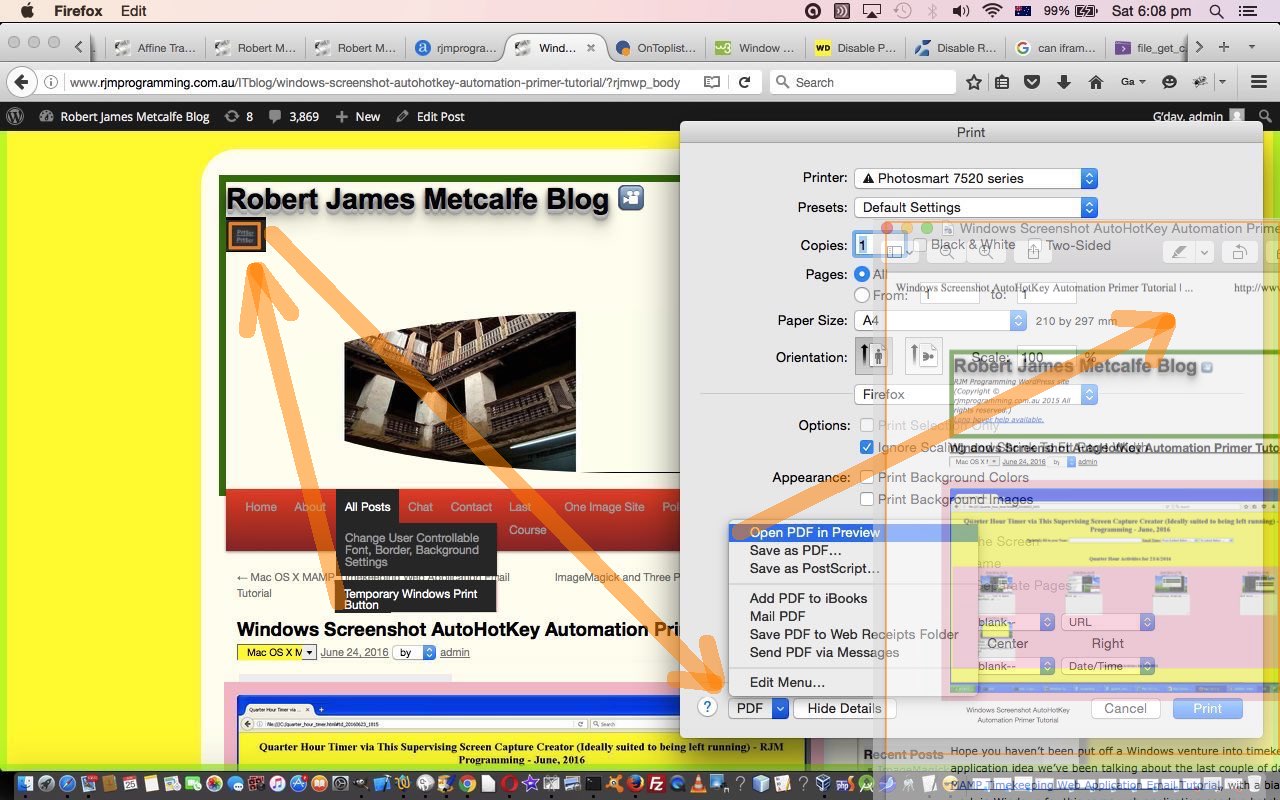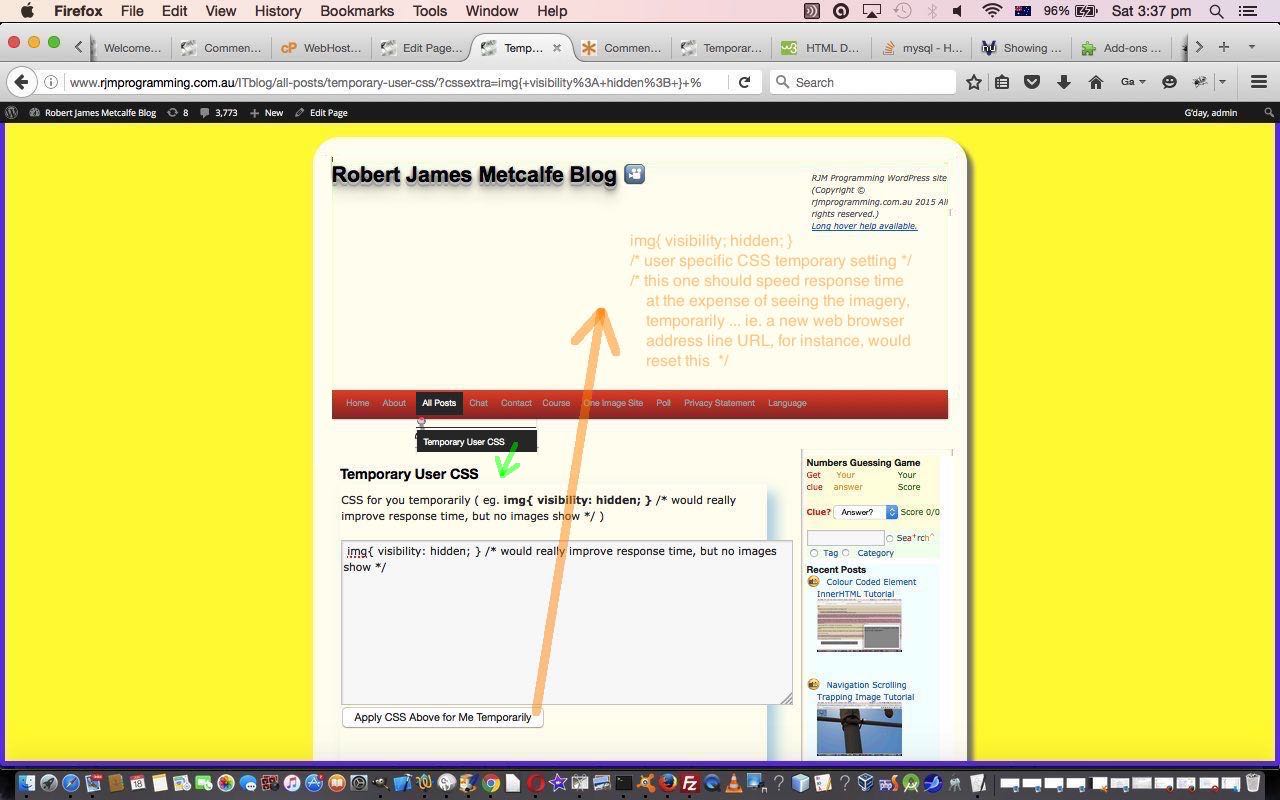A few different themes contribute to today’s tutorial about presenting a Print button, for a temporary timeframe for the current user only, for our WordPress Blog …
- document fidelity and the role of (hardcopy) PDF which we’ve discussed here before
- Print Screen snapshot ideas, we last talked about with Windows Screenshot AutoHotKey Automation Primer Tutorial
- temporary WordPress functionality specific to a user for a WordPress “session” … but note, our “session” is different to PHP’s $_SESSION[] scope, instead working with $_GET[] as the “session” mechanism … about which you can read more at WordPress Temporary User CSS Primer Tutorial as shown below
- limits of HTML iframe applicability, about which you can read more here, thanks … an “http[s]://” URL cannot iframe a “file://” URL, as much as we’d love to be able to do so today … it is a security risk to allow this … otherwise we’d have designed an instantly reactionary caller of Mac OS X (client computer) /usr/sbin/screencapture command to instantly snapshot the client screen … maybe you remember us not instantly using Mac OS X (client computer) /usr/sbin/screencapture command with crontab when we presented Mac OS X MAMP Timekeeping Web Application Email Tutorial recently
- similar PHP WordPress Twenty Ten theme (good ol’) header.php New Page submenu as shown below with WordPress Temporary User CSS Primer Tutorial … as below …
<head>
// Lots of other Javascript and CSS work
// ...
<style>
// Lots of other CSS work
// ...
if (isset($_SESSION['ourprint'])) {
echo str_replace('<' . 'style>','',str_replace('<' . '/style>','',$_SESSION['ourprint']));
} else if (file_exists("localprint_" . my_t_d_server_remote_addr() . ".yzy")) {
$lprint = str_replace('<' . 'style>','',str_replace('<' . '/style>','',file_get_contents(("localprint_" . my_t_d_server_remote_addr() . ".yzy"))));
$_SESSION['ourprint'] = $lprint;
echo $lprint;
unlink("localprint_" . my_t_d_server_remote_addr() . ".yzy");
} else if (isset($_GET['printask'])) {
} else if (isset($_GET['ourprint'])) {
$_SESSION['ourprint'] = urldecode($_GET['ourprint']);
echo $_SESSION['ourprint'];
} else if (isset($_GET['printextra'])) {
$_SESSION['ourprint'] = urldecode($_GET['printextra']);
echo $_SESSION['ourprint'];
} else if (strpos($_SERVER['QUERY_STRING'],'printextra=')) {
$sbits=explode("printextra=", str_replace('#','&',$_SERVER['QUERY_STRING']) . '&');
$ssbits=explode("&",$sbits[1]);
$_SESSION['ourprint'] = urldecode($ssbits[0]);
echo $_SESSION['ourprint'];
} else if (strpos($_SERVER['QUERY_STRING'],'ourprint=')) {
$sbits=explode("ourprint=", str_replace('#','&',$_SERVER['QUERY_STRING']) . '&');
$ssbits=explode("&",$sbits[1]);
$_SESSION['ourprint'] = urldecode($ssbits[0]);
echo $_SESSION['ourprint'];
}
</style>
… and …
function cookie_fonts() {
// Lots of other Javascript Cookie based work helping with control of some user styling settings discussed at ...
// https://www.rjmprogramming.com.au/ITblog/wordpress-user-body-background-primer-tutorial/
// ...
<?php
if (isset($_SESSION['ourprint'])) {
echo "\n" . ' appendtoa("printextra", "" + encodeURIComponent("' . $_SESSION['ourprint'] . '")); ' . "\n";
}
?>
}
// ...
// and then lots more down to (unchanged) end of head section and document.body onload (where cookie_fonts() is the last onload functionality) as per ...
// ...
</script>
</head>
<body onload=" setTimeout(initpostedoncc, 3000); sdescih(); widgetcon(); precc(); courseCookies(); cookie_fonts(); " <?php body_class(); ?>>
… and we realize that all the web browsers give this same “Print button” functionality available in their File -> Print submenus, but not reminding the user as much as today’s WordPress addition does to remind the user of this powerful means of communication and sharing with other users and email contacts, utilizing …
window.print();
… Javascript client-side web application functionality.
We’ll leave you with today’s live run link to a new WordPress submenu page.
Previous relevant WordPress Temporary User CSS Primer Tutorial is shown below.
CSS is, perhaps, best learnt with a varied palette to work with, to see how an effect you want to create both …
- works itself, as the concept you want to see … and …
- interacts with a wide variety of other cascading styling settings, in terms of its robustness, and hierarchy of usefulness … in other words, your CSS positioning may be very important regarding its workings
Today we introduce some functionality that allows you to use this blog, with its default styling as your palette as an experimental tool, perhaps, for your CSS testing.
In these terms we try to have your own CSS be last in the order of CSS interpreted by the web browser, but it is really up to you to see for yourself what you need to do to make things happen.
This change involved … you probably guessed it … tweaking WordPress TwentyTen theme’s good ol’ header.php … in two parts …
<head>
// Lots of other Javascript and CSS work
// ...
<style>
// Lots of other CSS work
// ...
if (isset($_SESSION['ourcss'])) {
echo str_replace('<' . 'style>','',str_replace('<' . '/style>','',$_SESSION['ourcss']));
} else if (file_exists("localcss_" . my_t_d_server_remote_addr() . ".yzy")) {
$lcss = str_replace('<' . 'style>','',str_replace('<' . '/style>','',file_get_contents(("localcss_" . my_t_d_server_remote_addr() . ".yzy"))));
$_SESSION['ourcss'] = $lcss;
echo $lcss;
unlink("localcss_" . my_t_d_server_remote_addr() . ".yzy");
} else if (isset($_GET['cssask'])) {
} else if (isset($_GET['ourcss'])) {
$_SESSION['ourcss'] = str_replace('<' . 'style>','',str_replace('<' . '/style>','',urldecode($_GET['ourcss'])));
echo $_SESSION['ourcss'];
} else if (isset($_GET['cssextra'])) {
$_SESSION['ourcss'] = str_replace('<' . 'style>','',str_replace('<' . '/style>','',urldecode($_GET['cssextra'])));
echo $_SESSION['ourcss'];
} else if (strpos($_SERVER['QUERY_STRING'],'cssextra=')) {
$sbits=explode("cssextra=", str_replace('#','&',$_SERVER['QUERY_STRING']) . '&');
$ssbits=explode("&",$sbits[1]);
$_SESSION['ourcss'] = str_replace('<' . 'style>','',str_replace('<' . '/style>','',urldecode($ssbits[0])));
echo $_SESSION['ourcss'];
} else if (strpos($_SERVER['QUERY_STRING'],'ourcss=')) {
$sbits=explode("ourcss=", str_replace('#','&',$_SERVER['QUERY_STRING']) . '&');
$ssbits=explode("&",$sbits[1]);
$_SESSION['ourcss'] = str_replace('<' . 'style>','',str_replace('<' . '/style>','',urldecode($ssbits[0])));
echo $_SESSION['ourcss'];
}
</style>
… and …
function cookie_fonts() {
// Lots of other Javascript Cookie based work helping with control of some user styling settings discussed at ...
// https://www.rjmprogramming.com.au/ITblog/wordpress-user-body-background-primer-tutorial/
// ...
<?php
if (isset($_SESSION['ourcss'])) {
echo "\n" . ' appendtoa("cssextra", "" + encodeURIComponent("' . $_SESSION['ourcss'] . '")); ' . "\n";
}
?>
}
// ...
// and then lots more down to (unchanged) end of head section and document.body onload (where cookie_fonts() is the last onload functionality) as per ...
// ...
</script>
</head>
<body onload=" setTimeout(initpostedoncc, 3000); sdescih(); widgetcon(); precc(); courseCookies(); cookie_fonts(); " <?php body_class(); ?>>
So if you want to try your own CSS try this live run link, and see, below, some other suggestions (which simulate what the All Posts -> Temporary User CSS submenu does), that, if you click, and you want to reset use this reset link here.
- *{font-family: “Comic Sans MS”, “Comic Sans”, cursive;}
- p{background-color:silver;}
- ul li:nth-child(3):before{background-color: violet;} /* violet will show under emoji to left */
If this was interesting you may be interested in this too.
If this was interesting you may be interested in this too.




